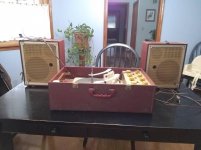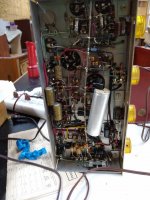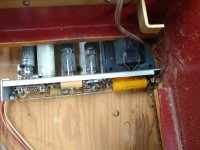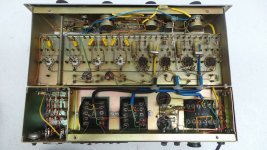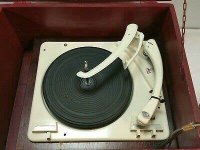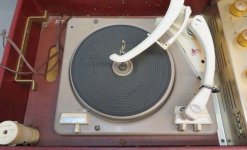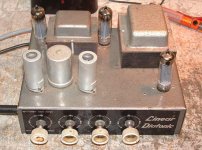I need help identifying this system.It is well constructed including tying the foil on the capacitors to ground.I have started restoration that will begin with drawing a schematic for it.I would be grateful for any info.Thanks
Attachments
"Universal Audio Laboratories" is on the bottom of the front panel in the second picture.
See if there is any info on that.
Sam's Photofact, perhaps?
See if there is any info on that.
Sam's Photofact, perhaps?
Old POS, open wiring.
Long job, sound quality will be average to poor if TO-3 are used.
Unless it is a family heirloom, I would not spend time on it.
Long job, sound quality will be average to poor if TO-3 are used.
Unless it is a family heirloom, I would not spend time on it.
Thank you very much.I contacted the people at"Universal Audio Laboratories"they told me if anything it was before their time.They did give me a lead though.I contacted the person and he never responded.No luck with Sams either."Universal Audio Laboratories" is on the bottom of the front panel in the second picture.
See if there is any info on that.
Sam's Photofact, perhaps?
Thank you very much.I have a couple of questions:What is "Old POS,open wiring and what is TO-3?Old POS, open wiring.
Long job, sound quality will be average to poor if TO-3 are used.
Unless it is a family heirloom, I would not spend time on it.
POS, please, rude description, look it up.
Open wiring means no PCB, all the components are connected with wires, very messy and unreliable.
TO-3 is a style of transistor case, almost out of production, and those transistors were not very good in terms of sound quality.
So my conclusion was that this is like an old Pontiac or Chevrolet, not really worth the work, unless it was a family heirloom.
Open wiring means no PCB, all the components are connected with wires, very messy and unreliable.
TO-3 is a style of transistor case, almost out of production, and those transistors were not very good in terms of sound quality.
So my conclusion was that this is like an old Pontiac or Chevrolet, not really worth the work, unless it was a family heirloom.
Open wiring means no PCB, all the components are connected with wires, very messy and unreliable.
The valve amplifier I bought over 50 years ago does not employ printed circuit boards and it is still going strong today.
Its point to point wiring (admittedly neater than that of the OP's amp) makes it particularly easy to service (internet image attached).
Attachments
Look at the tone arm in the OP photos, looks like a kids' picnic toy...
Your unit looks well made, or at least somebody did a lot of work to achieve that result.
And tubes are different in performance than old 2N3055 class transistors, if those are indeed the ones used as final output stages.
I stand by my conclusion.
Your unit looks well made, or at least somebody did a lot of work to achieve that result.
And tubes are different in performance than old 2N3055 class transistors, if those are indeed the ones used as final output stages.
I stand by my conclusion.
And tubes are different in performance than old 2N3055 class transistors, if those are indeed the ones used as final output stages.
But... The OP's amp is a valve amp - no TO3 transistors involved.
My mistake, then.
I apologize...
So it will take a lot of sorting out, as high voltages and old tubes are involved.
But we must ask the type of tubes used, that ought to give a pretty good idea of the circuit, and some repairs can be done...
I apologize...
So it will take a lot of sorting out, as high voltages and old tubes are involved.
But we must ask the type of tubes used, that ought to give a pretty good idea of the circuit, and some repairs can be done...
Well thank you for the education.I happen to do know what a TO-3 packageis but there are none in the pictures I posted.As far as point to point wiring I totally disagree with you.When done with care they perform quite well.POS, please, rude description, look it up.
Open wiring means no PCB, all the components are connected with wires, very messy and unreliable.
TO-3 is a style of transistor case, almost out of production, and those transistors were not very good in terms of sound quality.
So my conclusion was that this is like an old Pontiac or Chevrolet, not really worth the work, unless it was a family heirloom.
EDIT: I meant Garrard 210!
Could be a 209: 210 has removeable headshell while 209 has integral headshell.
Could be a 209: 210 has removeable headshell while 209 has integral headshell.
Last edited:
https://en.wikipedia.org/wiki/Universal_Audio_(company)
The unit in the picture posted above has tubes made in Great Britain.
I wonder if it is the same company.
Anyway, should be easy to do servicing if needed.
The unit in the picture posted above has tubes made in Great Britain.
I wonder if it is the same company.
Anyway, should be easy to do servicing if needed.
Last edited:
I found more photos of the Minuet system here: https://archive.org/details/20220424_20220424_0456/bandicam 2022-04-24 00-55-34-689.jpg
The record changer is a Garrard 210 which dates from around 1959.
The record changer is a Garrard 210 which dates from around 1959.
Attachments
Now that we know there were no TO-3 in that amplifier,
I am a vacuum tube amplifier fan, but . . .
Not all TO-3 packages were 2N3055 NPN Bipolar transistors.
Did you ever hear any of Erno Borbely's solid state amplifier designs, that used Hitachi's N-channel and P-channel V-FETs in totem pole mode?
Harmon Kardon, and some other manufacturers very successfully used those Hitachi TO-3 V-FETs too.
Those amplifiers may, or may not, be what some people like; to each his own.
Learn to enjoy good sounding systems even if they are not among the best sounding.
Much of how good a system sounds, is dependent on the Synergy of the complete set of the components.
I hate to say it, but my old Dynaco kit amplifier sounded OK (back in the day).
It had Pseudo-Complimentary (wrap around) 2N3055 totem pole outputs.
My KLH speakers worked well then.
My first amplifier was a mono Knight Kit push pull EL84 with 12AU7 gain and phase splitter; and 12AX7 phono preamp.
It drove Electro Voice and Stephens speakers . . . full range, and 2-way with Horn Tweeter. Very Enjoyable, but what did I know back then?
I am a vacuum tube amplifier fan, but . . .
Not all TO-3 packages were 2N3055 NPN Bipolar transistors.
Did you ever hear any of Erno Borbely's solid state amplifier designs, that used Hitachi's N-channel and P-channel V-FETs in totem pole mode?
Harmon Kardon, and some other manufacturers very successfully used those Hitachi TO-3 V-FETs too.
Those amplifiers may, or may not, be what some people like; to each his own.
Learn to enjoy good sounding systems even if they are not among the best sounding.
Much of how good a system sounds, is dependent on the Synergy of the complete set of the components.
I hate to say it, but my old Dynaco kit amplifier sounded OK (back in the day).
It had Pseudo-Complimentary (wrap around) 2N3055 totem pole outputs.
My KLH speakers worked well then.
My first amplifier was a mono Knight Kit push pull EL84 with 12AU7 gain and phase splitter; and 12AX7 phono preamp.
It drove Electro Voice and Stephens speakers . . . full range, and 2-way with Horn Tweeter. Very Enjoyable, but what did I know back then?
My first amplifier was a mono Knight Kit push pull EL84 with 12AU7 gain and phase splitter; and 12AX7 phono preamp.
It drove Electro Voice and Stephens speakers. Very Enjoyable, but what did I know back then?
My first separate valve amplifier was a mono Linear Diatonic 15W pp EL84.
The Diatonic graduated to fill a community hall full of sound during weekly 'record sessions' for pre-teens - an embryonic 'discotheque', but without the lighting effects. Of course, the large speakers I installed in the hall were very efficient!
Attachments
The OP unit needs a complete inspection, mechanical and electronic.
The tubes, soldering, capacitor replacement, and so on.
And since high voltages are involved, the power supply will need a very close look.
The record changer, also, it is after all from circa 1960.
I think the unit was a semi-portable record player similar to the photo Galu posted, something to use with a mains supply, and move around to a balcony or room, and store away when not in use.
Due to high voltage, I do not know if battery operated valve units were sold commercially, I would expect a mains supply, so not something you could use at a beach.
On the other hand, due to the use of tubes, a fairly good idea of the circuit can be obtained on line, and those component values can be verified.
The tubes will need testing as well for their parameters.
All in all, a lot of work, and some difficulty will be encountered, spare tubes are sometimes difficult to find.
The use of British tubes means that it could have been made in the UK, and the name could have been coincidentally similar to the US company.
There are long lists of defunct manufacturers of audio equipment available on line, across the world. It is entirely possible that the maker is out of business, so the approach will have to be from the basics.
And it depends a lot on how the unit was used and stored for all these years.
The tubes, soldering, capacitor replacement, and so on.
And since high voltages are involved, the power supply will need a very close look.
The record changer, also, it is after all from circa 1960.
I think the unit was a semi-portable record player similar to the photo Galu posted, something to use with a mains supply, and move around to a balcony or room, and store away when not in use.
Due to high voltage, I do not know if battery operated valve units were sold commercially, I would expect a mains supply, so not something you could use at a beach.
On the other hand, due to the use of tubes, a fairly good idea of the circuit can be obtained on line, and those component values can be verified.
The tubes will need testing as well for their parameters.
All in all, a lot of work, and some difficulty will be encountered, spare tubes are sometimes difficult to find.
The use of British tubes means that it could have been made in the UK, and the name could have been coincidentally similar to the US company.
There are long lists of defunct manufacturers of audio equipment available on line, across the world. It is entirely possible that the maker is out of business, so the approach will have to be from the basics.
And it depends a lot on how the unit was used and stored for all these years.
Last edited:
- Home
- Amplifiers
- Tubes / Valves
- Need Help Identifying A Stereo/Amp System
